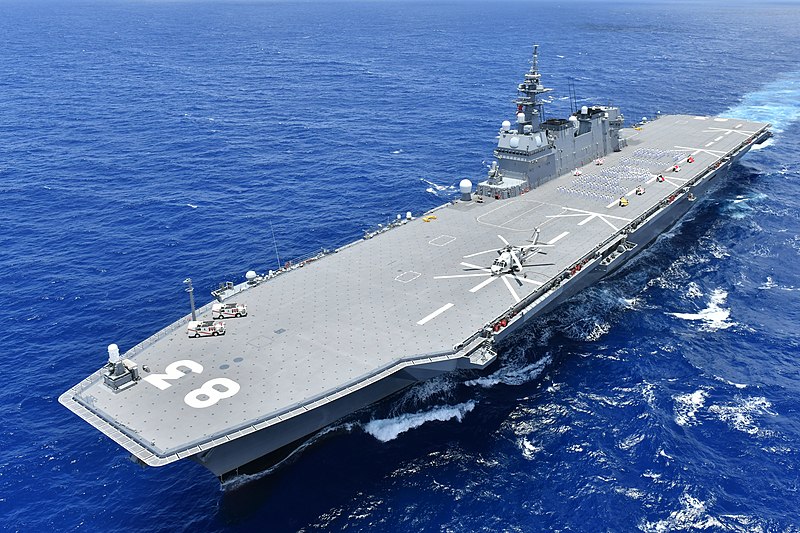It's probably nothing.
Or at least that's what The Diplomat seems to be saying:
April 7, 2021
Yes, China Has the World’s Largest Navy. That Matters Less Than You Might Think.
China’s fleet relies disproportionately on smaller classes of ships – and U.S. capabilities are bolstered by its allies’ navies.
Since the release of the Department of Defense’s “2020 China Military Power Report” this past September, much has been made of China’s securing the title of the “world’s largest navy.” Indeed, the United States Office of Naval Intelligence has confirmed that the People’s Liberation Army Navy (PLAN) has surpassed the United States Navy in total battle force ships, approximately 360 to 297, with future projections expecting the gap to grow. By 2025, the PLAN is predicted to field as many as 400 vessels whereas the United States plans only to field 355. Quantitative discussions of this sort have fostered an increasing level of hysteria in the U.S. media and even parts of its foreign policy and defense establishments.
What such discussions fundamentally misunderstand about the two fleets, however, are the major differences in force structure as well as the incomparable regional ally differential maintained by the United States. In fact, most discussions about the size of the PLAN inflate its surface warship fleet by including either small coastal patrol ships or its amphibious transports and landing ships.
In order of descending size, the PLAN’s surface force is comprised of two aircraft carriers, one cruiser, 32 destroyers, 49 frigates, 37 corvettes, and 86 missile-armed coastal patrol ships. In addition, China’s submarine fleet includes 46 diesel-powered attack submarines, six nuclear-powered attack submarines, and four ballistic missile submarines. This is further supplemented by the China Coast Guard, which fields roughly 255 coastal patrol ships. In sum, China has a surface warship fleet of 121 vessels, a submarine fleet of 56 platforms, and another 341 coastal patrol ships.
For its part the United States Navy boasts a surface fleet of 11 aircraft carriers, 92 cruisers and destroyers, and 59 small surface combatants and combat logistics ships. Its submarine fleet is comprised of 50 attack submarines, 14 ballistic missile submarines, and four cruise missile submarines. As such, the United States maintains a surface fleet of about 162 vessels, depending on the inclusion of its small combatants and combat logistics ships, and a submarine fleet of 68 platforms....
....MUCH MORE
Yet, despite the reassuring words, China just keeps building and building. From DefenseNews, April 26:
China simultaneously commissions three warships on Navy anniversary
MELBOURNE, Australia — China commissioned 60,000 tons worth of major vessels earlier this month, officially putting into service a new nuclear-powered ballistic missile submarine, a guided-missile cruiser and an amphibious helicopter carrier on the 72nd anniversary of its Navy.
The unprecedented triple commissioning was carried out in a ceremony held at the Yulin naval complex near the city of Sanya on the southern Chinese island of Hainan. Yulin is the main naval base of the South Sea Fleet of the People’s Liberation Army Navy. The fleet’s area of responsibility lies in the waters of the nearby South China Sea.
Chinese President Xi Jinping attended the ceremony, which saw the Type 075 (Yushen-class) amphibious helicopter carrier Hainan, the Type 055 (Renhai-class) guided-missile cruiser Dalian and the Type 094 (Jin-class) nuclear-powered ballistic missile submarine Changzheng-18 join the PLAN.
The Hainan is the lead ship of a new class of amphibious assault ships being built for the PLAN as it continues to boost its naval capabilities. The helicopter carriers, which are estimated to displace between 35,000 to 40,000 tons, have an uninterrupted flight deck with seven deck spots for large transport helicopter operations, and a well dock for launching conventional or air-cushioned landing craft for amphibious landing operations...
....MUCH MORE
Now I don't care who you are, a 35,000 ton helicopter carrier is a big boat with major capabilities.
Here's the Japanese 27,000 tonne helicopter carrier Izumo:

It would take very little in the way of modifications to haul Short Take Off/Vertical Landing F-35 fighters. Ditto for the larger Chinese helicopter carriers.
And even if they stick to the smaller ships, under the right captain the smaller boats can raise havoc.
In last December's "Meanwhile, in the Mediterranean: Egyptian Frigate Goes All Medieval On Turkish Frigate" our introduction was:
There's something so primitive and basic about ramming that it gets the intended rammee's attention when the position is assumed..
Granted, this wasn't as dramatic (or suicidal) as the little American destroyer escort, Samuel B. Roberts charging at the Japanese armada (eleven destroyers, eight cruisers, and four battleships) at the Battle of Samar but again, it is just so basic that the Turks couldn't help but notice when the Egyptians turned toward them.
Ever since I first heard of the charge of the tiny (1,350 tons) boat at the 23 Japanese ships I've wondered what the Japanese were thinking as the Roberts came at them.
The Samuel B. Roberts blew the stern off one Japanese heavy cruiser (it later sank) and set another heavy cruiser ablaze before one of the battleships was able to react and shell the Roberts forcing the order to abandon ship.